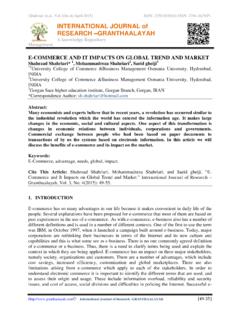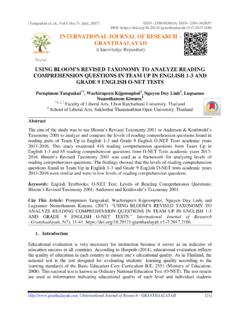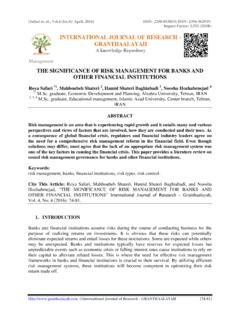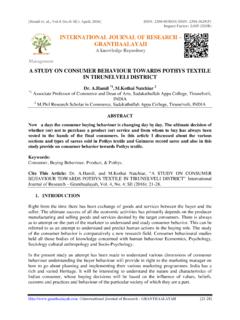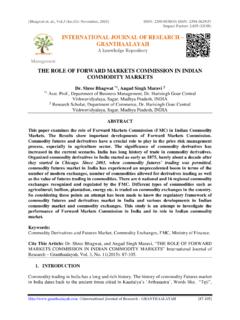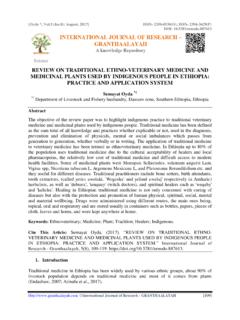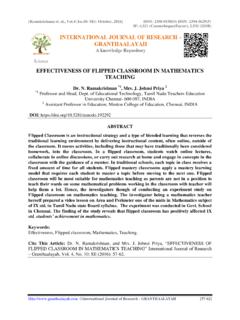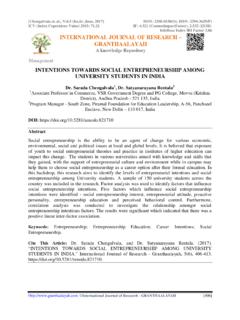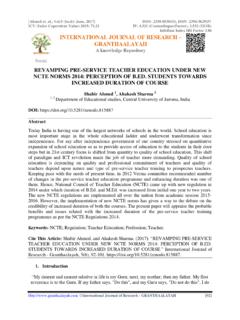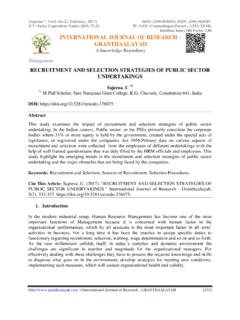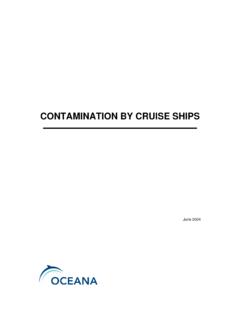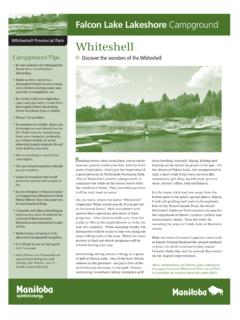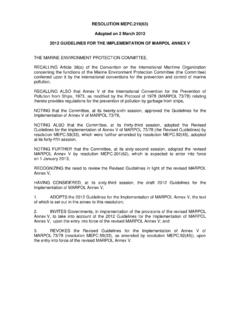Transcription of REVIEW OF THE GREYWATER AND PROPOSED …
1 [Albalawneh et. al., ( ): December, 2015] ISSN- 2350-0530(O) ISSN- 2394-3629(P) Impact Factor: (I2OR) International Journal of Research - GRANTHAALAYAH [16-35] Science REVIEW OF THE GREYWATER AND PROPOSED GREYWATER RECYCLING SCHEME FOR AGRICULTURAL IRRIGATION REUSES Abeer Albalawneh *1, Tsun-Kuo Chang 2 *1, 2 Department of Bioenvironmental Systems Engineering, National Taiwan University, Taipei 10610, TAIWAN ABSTRACT In this study, we reviewed GREYWATER characteristics and various treatment technologies with the aim of coming up with the schematic of GREYWATER recycling system designed specifically for restricted agricultural irrigation reuse.
2 Characteristics of GREYWATER are highly variable; GREYWATER amount varies from 50% to 80% of the wastewater volume produced by households. All types of GREYWATER show good biodegradability in terms of COD: BOD5 ratios. The ratio of BOD5/COD in GREYWATER ranged from to Most countries apply the same standards to reclaimed municipal wastewater as they do to GREYWATER . However, some countries have established specialized standards for GREYWATER reuse. Technologies used for GREYWATER treatment are classified into physical, chemical, biological, and natural systems, or a combination of these. Using physical GREYWATER treatment processes solely as the main treatment method is insufficient for GREYWATER treatment, chemical GREYWATER treatment processes are attractive for single household low-strength GREYWATER treatment systems, as the variability in the strength and flow of the GREYWATER did not affect their treatment performance.
3 Constructed wetland can be regarded as the most environmentally friendly and cost-effective technology for GREYWATER treatment and reuses. Finally, the study suggests the possible GREYWATER recycling scheme for agricultural irrigation reuse purposes. Keywords: GREYWATER quantity; GREYWATER treatment; GREYWATER quality; GREYWATER irrigation. Cite This Article: Abeer Albalawneh and Tsun-Kuo Chang, REVIEW OF THE GREYWATER AND PROPOSED GREYWATER RECYCLING SCHEME FOR AGRICULTURAL IRRIGATION REUSES International Journal of Research Granthaalayah, Vol. 3, No. 12(2015): 16-35. 1. INTRODUCTION As the world s freshwater supply becomes increasingly scarce, increased attention towards alternative water resources has become necessary.
4 Water reuse is gaining significant momentum in discussions about sustainable water resource management, green economies, and urban planning. GREYWATER reuse is a promising alternative water source, which could be exploited on [Albalawneh et. al., ( ): December, 2015] ISSN- 2350-0530(O) ISSN- 2394-3629(P) Impact Factor: (I2OR) International Journal of Research - GRANTHAALAYAH [16-35] a continuous basis and treated for non-potable uses (Chong et al., 2015). Increasingly, GREYWATER use is seen as an essential component of local and national efforts to adapt to climate change, enhance food security, extend potable water supply, and reduce pollutants in the environment (Drechsel et al.)
5 , 2015). GREYWATER treatment methods vary based on site conditions and GREYWATER characteristics. The design of a GREYWATER treatment system primarily depends on water quality, the quantity to be treated, and the reuse applications. A wide range of GREYWATER treatment technologies have been applied and examined and they produce effluents with different qualities. In this study, we reviewed GREYWATER characteristics and various treatment technologies with the aim of coming up with a schematic of GREYWATER recycling system designed specifically for restricted agricultural irrigation. The issues considered in this study include GREYWATER characteristics, guidelines, current treatment technology performance.
6 2. GREYWATER CATEGORIES GREYWATER is defined as wastewater that includes water from baths, showers, hand basins, washing machines, dishwashers, and kitchen sinks, but excludes streams from toilets (Jefferson et al., 2000; Eriksson et al., 2002; Friedler and Hadari, 2006; WHO-guidelines, 2006). Some authors exclude kitchen wastewater from the other GREYWATER streams (Christova-Boal et al., 1996; Al-Jayyousi, 2003; Ghunmi, 2009). Wastewater from the bathroom, including showers and tubs, is termed light GREYWATER (Friedler and Hadari, 2006). GREYWATER that includes more contaminated waste and from laundry facilities, dishwashers and, in some instances, kitchen sinks is called dark GREYWATER (Birks and Hills, 2007).
7 Some GREYWATER sources and their constituents are presented in Figure 1. References:(Noah, 2002; Morel and Diener, 2006; Ghaitidak and Yadav, 2013) Figure 1: GREYWATER sources and their constituents. [Albalawneh et. al., ( ): December, 2015] ISSN- 2350-0530(O) ISSN- 2394-3629(P) Impact Factor: (I2OR) International Journal of Research - GRANTHAALAYAH [16-35] 3. CHARACTERISTICS OF GREYWATER OF GREYWATER Water consumption always depends on the quality of life standards and availability of resources. The quantity of GREYWATER generation depends on the total water consumption, living standard, population structures ( , age, gender), resident habits, and water installations of a given population (Morel and Diener, 2006; Ghaitidak and Yadav, 2013).
8 Therfore, GREYWATER varies from 50% to 80% of the wastewater volume produced by households (Jenssen and Vr le, 2003; Flowers, 2004), and over 90% if vacuum toilets are installed Leal et al. (2011). The typical volume of GREYWATER varies from 90 to 120 l/p/d, however the volume of GREYWATER in low income countries that experience chronic water shortages can be as low as 20 30 l/p/d (Morel and Diener, 2006). The quantity of GREYWATER also varies between urban and rural area, as shown in Figure 2. The published literature indicates that about 27% of GREYWATER originates from the kitchen sink and dishwasher, 47% originates from the wash basin, bathroom, and shower, and 26% originates from laundry and the washing machine.
9 (Jamrah et al., 2006; Al-Mughalles et al., 2012; Ghaitidak and Yadav, 2013). References: (1):(Perth, 2008), (2&5):Harikumar and Mol (2012), (3):Jamrah et al. (2006), (4):Al-Mughalles et al. (2012), (6):Al-Hamaiedeh and Bino (2010), (7):Halalsheh et al. (2008). Figure 2: The volume of GREYWATER generated in various rural and urban areas OF GREYWATER Grey water is generated as a result of the living habits of the people involved. Therefore, its characteristics are highly variable and influenced by lifestyle, the social and cultural behavior of the residents, the availability of water, and the consumption amount (Eriksson et al., 2002; Jefferson et al.)
10 , 2004; Uddin et al., 2015). GREYWATER includes different ranges of organic matters (Halalsheh et al., 2008), suspended solids, heavy metals (Palmquist and Han us, 2005), in-organic ions (Eriksson and Donner, 2009), and (Winward et al., 2008). Although the levels of these pollutants in GREYWATER are presumed to be lower compared to wastewater, many studies have observed the opposite (Halalsheh et al., 2008; Bino et al., 2010; Dalahmeh et al., 2011). For example, BOD5 in composite GREYWATER samples collected from rural villages in Jordan reached [Albalawneh et. al., ( ): December, 2015] ISSN- 2350-0530(O) ISSN- 2394-3629(P) Impact Factor: (I2OR) International Journal of Research - GRANTHAALAYAH [16-35] 1,400 mgL-1 in some cases, which is even higher than the concentration reported in concentrated wastewater (Assayed, 2014).
